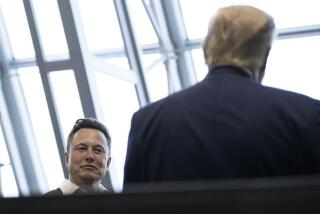Twitter tries to turn 140 characters into money
Reporting from San Francisco â On âThe Tonight Show,â Conan OâBrien used to get big laughs for mocking Twitter as an egotistical stream of mundane updates from celebrities.
But when he got bounced from his late-night gig at NBC, OâBrien could no longer take to the airwaves to reach his fans, so Twitter became his open hailing frequency. He later thanked Twitter âfor saving my ass.â
OâBrien isnât the only one who is tapping Twitterâs mass-media potential. The social network, which will celebrate its five-year anniversary in March, last year signed up more than 100 million people who sent more than 25 billion updates called tweets.
Twitter Inc. gained another key following in December: investors who competed for the opportunity to pour $200 million into the company, nearly quadrupling its worth to $3.7 billion. The new funding comes even as the company experiments with how to wring sales from its surging popularity and find the kind of business formula that shot up the fortunes of Facebook Inc. and Google Inc.
Now Twitter finds itself at a crossroads, where it will finally have to answer the question: Can it make money?
â2010 was the year Twitter became a phenomenon,â said Forrester Research analyst Augie Ray, who tracks Twitter. â2011 will be the year that they have to prove they are a business.â
The man in charge of turning Twitter into a business is Dick Costolo, a former improvisational comedian turned technology entrepreneur who joined Twitter in 2009 as chief operating officer. Costolo, who replaced Twitter co-founder and product guru Evan Williams as chief executive in October, is credited with helping Twitter roll out advertising initiatives that have attracted more than 80 big brands such as Starbucks Corp., Coca-Cola Co. and the airline Virgin America.
It will now be up to Costolo to determine whether Twitter becomes the next major independent Internet company like Facebook or the next promising start-up to get bought or flame out like News Corp.âs MySpace.
Even with surging interest in Twitter, Costolo insists âwe have every intention of remaining independent.â
Twitter has turned down takeover offers from Google and Facebook, and intends to compete with them for users and advertising dollars. Costolo wrote in a recent tweet that âtoo many people worry about exit strategies when they should be worrying about entrance strategies.â
Part of his entrance strategy was helping Twitter raise cash to expand while relieving pressure for an initial public stock offering, which Costolo says is still on the distant horizon.
That investors valued Twitter at nearly $4 billion reflects its potential, not its actual business. Twitter will bring in $150 million in revenue this year, more than triple its revenue of $45 million in 2010, the first year the company sold advertising, according to research firm EMarketer. By 2012 Twitterâs revenue will reach $250 million, far less than Facebook but more than News Corp.âs MySpace, EMarketer predicts. But thatâs only if Twitter can live up to its hype and show advertisers itâs a must buy.
In addition to advertising, Twitter gets millions of dollars from Google and Microsoft Corp. to show tweets to users of their search engines. Twitter does not disclose its financial information, but those distribution deals, worth about $25 million, were enough to make it profitable in 2009.
âTwitter is big, itâs here to stay and itâs an important part of the Internet,â said Twitter investor Fred Wilson of Union Square Ventures. âWhat has to happen next is that Twitter has to figure out how to make money. Thatâs the next step, and they are well on their way.â
The Webâs third-most-popular social network began as a side project growing out of founders Biz Stone and Williamsâ work on blogging software and Twitter Chairman Jack Dorseyâs fascination with dispatch systems. Twitter lets users send 140-character messages, or tweets, to followers. Now more than 95 million messages ricochet around the world each day, spreading news instantly. More and more people are taking part in this global conversation.
Twitter has been embraced by political leaders and celebrities who use it to promote themselves and companies that use it to promote their products. The NFL is creating a feed of updates from players, coaches and fans in the buildup to the Super Bowl.
Protestors in Tunisia seized on Twitter to foment a revolution that might have been crushed without the viral power of Facebook and Twitter to instantly spread news and video. The torrent of firsthand accounts from around the globe has achieved such cultural significance that the Library of Congress plans to archive them.
Twitter also was instrumental in fueling dissent this week against Egyptian President Hosni Mubarakâs 30-year rule, accelerating the flow of news and video and connecting protestors until Egyptâs government pulled the plug on the Internet.
Twitterâs influence is still dwarfed by Facebook, which has more than half a billion users and a vast global reach. A recent Pew Internet & American Life Project study showed that only 8% of adult Internet users in the U.S. use Twitter.
âIn some ways people have found that Twitter is not the be all, end all Democratic platform,â Internet culture expert Tim Hwang said.
Yet Twitter is one of the rare Internet companies to make such a big splash in the mainstream. It has been likened to social networking service Facebook and Google in their early days. Twitter has become so ubiquitous that, like Google, tweet is now a verb.
The success of Twitter has turned its low-key founders Stone and Williams into Internet celebrities. Twitterâs San Francisco headquarters has played host to Russian President Dmitry Medvedev, who sent his first tweet from there, and hip-hop star Kanye West, who performed lyrics from his upcoming album.
And Stone was recently a surprise guest on âThe Colbert Reportâ to give host Stephen Colbert the first-ever Golden Tweet award for the most retweeted (as in popular) update of 2010 about the BP oil spill: âIn honor of oil-soaked birds, âtweetsâ are now âgurgles.ââ
Despite all the hobnobbing, Twitterâs offices are as democratic as the service. Company executives sit elbow to elbow at long desks and lunch at small tables with employees. Staffers flock to meeting rooms named for different types of birds. They take breaks to learn âtwideokinetics,â a combination of meditation and martial arts, with Twitter Chief Technology Officer Greg Pass or take a jog with Tweetfeet, the company running club. Each new employee gets a copy of Twitterâs 10 operating principles (âbe a force for goodâ and âmake things happenâ among them).
Stone said he was proud of Twitterâs corporate culture, which has drawn top recruits from Facebook, Google and YouTube.
âTwitter was built on the fundamental belief that people are good and that if you give them the tools, they will do good things,â Stone said.
Now Costolo is bringing business discipline to Twitter. The 350-person company is building data centers to cope with crushing traffic and has hired 250 people in the last year alone. Itâs trying to combat its image as an innovation laggard. And it has clarified its vision: Itâs billing itself as an information network that connects people to whatâs important to them as it happens.
Costolo is the quintessential operating executive whose job is to bring âorder, focus, calm and execution,â Twitter investor Wilson said.
For much of its young life, Twitter had no real plan except to keep up with its explosive growth â and to keep its users from seeing the âfail whale,â the cuddly cartoon mammal that surfaces when Twitter is flooded with too much traffic.
Co-founder Williams said he was amazed that the service kept growing in popularity even when for so long there were so many hurdles to using it. Last fall he oversaw a redesign of Twitterâs website that made it easier for users to post photos and videos, and easier for marketers to reach out to those users.
âNow we have gotten to the point that we can rise to the challenge,â Williams said. âWe are building on the lessons of the last couple of years that have shown us what Twitter is and how to run it.â
The challenge is twofold: making the product easier and more engaging and, most important, making money.
Social media networks have been reluctant to flood their sites with ads targeting the millions of people who interact with one another online. Instead they have sought out less obtrusive and more natural ways to connect users with marketers.
For Twitter, that has meant trying to come up with ads that are so relevant and useful that users donât think of them as ads.
Costolo claims Twitter has âcracked the codeâ on that kind of advertising and predicts advertisers will soon spend millions of dollars on Twitter. Analysts say Twitterâs efforts so far are promising.
Called Promoted Tweets and Trends, these ads show up at the top of Twitter feeds or trends. Advertisers pay anytime someone interacts with the Twitter update by clicking on a link, forwarding the update to friends or replying to it.
On average 5% of Twitter users who see a promoted Tweet interact with it, a rate that Costolo said was âan order of magnitude greaterâ than most online ad campaigns. Promoted Trends go for as much as $100,000 for a single 24-hour campaign.
Virgin America, for one, is a fan of Twitter advertising. The airline promoted the launch of its new service to Toronto in April by offering special discounts to Twitter users. The promotion gave Virgin America its fifth-highest sales day.
âWe have definitely seen great success in partnering with Twitter,â said Jill Fletcher, Virgin Americaâs social media and communications manager.
But some advertisers are not yet sold. Costolo is banking that will soon change. He concedes that there is âa ton of work left to do on the advertising platform,â but says he has never seen an advertising business work so well so quickly.
Twitter is ramping up by building a national sales force, hiring executives from Facebook and Google, and expanding its reach overseas, where it is experiencing torrid growth. It must continue that pace to succeed as a major Internet player.
âWe all believe that Twitter could be one of the great Internet companies,â Costolo said. âWe know we have to prove that, and we know we have a lot of work to do.â
More to Read
Inside the business of entertainment
The Wide Shot brings you news, analysis and insights on everything from streaming wars to production â and what it all means for the future.
You may occasionally receive promotional content from the Los Angeles Times.










